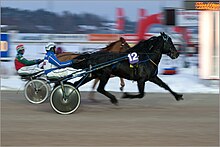Coldblood trotter

A Coldblood Trotter of mixed Swedish and Norwegian lines
|
|
| Country of origin | Norway and Sweden |
|---|---|
| Traits | |
| Distinguishing features | Heavy horse bred for harness racing |
| Breed standards | |
A Coldblood Trotter may belong to either one of two closely related and interconnected breeds of horse: the Norsk Kaldblodstraver (Norwegian Coldblood Trotter) and the Svensk Kallblodstravare (Swedish Coldblood Trotter). Coldblood trotters, also known widely in international breed registries as Draft Trotters, are the result of crossbreeding lighter and faster horses with native coldblooded farm horses, either the Norwegian Dølehest or the North Swedish Horse. Although the Norwegian and Swedish coldblood trotters are substantially considered a single breed, two national studbooks are maintained, and registration requirements differ in some respects between the two countries.
The average height at the withers for stallions is 154 cm (15.1 hands), and all individuals should stand at least 148 cm (14.2 hands). Bay in all its variations is the most common coat colour, followed by chestnut and black. The dun gene and cream gene are present in the genetic material, but not white nor any variations of pinto.
The Coldblood Trotter has a relatively small and square head with large nostrils. It is well suited for the cold conditions in Scandanivia, and it can develop large amounts of winter hair, having less need for blankets in winter. Compared to the Standardbred it is smaller, heavier, and more compact in build. It is not as fast as the Standardbred. The Coldblood Trotter is mostly bred in Norway and Sweden. Coldblood Trotters are very rarely found outside the Nordic Countries.
The coldblood trotter is bred for use in harness racing. The two types compete in shared heats that exclude entry of light trotter breeds or Finnhorses.
...
Wikipedia
